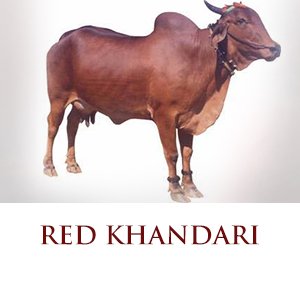Red Kandhari

Red Kandhari or Lal Kandhari has habitat in Maharashtra, in the Kanpur and Nanded districts, in some pockets of Ahmedpur and Parli districts, Hingoli tehsil of Latur district and in Beed and Parbhani districts of the Marathwada region. This breed also habitats Bidar District in Karnataka.
Pure form of this breed habitats Nanded district which is its breeding tract as climate is dry and semi-arid. It is a medium-sized, good-looking and robust animal. The cows are good milkers. The bullocks are good draught animals. They are useful for heavy agricultural work like ploughing and carting, as well as for transportation.
Characteristics:-
- The body is compact and built square with well proportionate limbs.
- The color is generally a uniform, dark red though, at times it varies from a dull red to almost dark brown. The breeding bulls are darker than other animals.
- The forehead is broad between the eyes and bulging, with long ears dropping sidewise. Horns are even, curved and medium sized.
- The ears are long, dropping side wise with rounded tips.
- The eyes are shining and having black colored rings around it.
- The navel flap is tiny in the cows and the sheath tucks into the body.
- The tail is well set on the body, broad, tapering, moderate long with a black switch which extends below the hocks.
- The skin is drawn tight over the body with small short glossy hair.
- The udder is small and tucked up and the teats are small but placed in squares.
- The dewlap is moderate and so also is the hump.
- Body length of males is about 118cms while that of females is about 110 cms.
- The height at the withers for males is 131 cms and for females about 128 cms.
- The age at first calving ranges from 30 to 45 months.
- The lactation period is about 280 days.
- The milk production per lactation ranges from 400 to 600 kgs per lactation.
- The carving interval ranges from 360 to 700 days.
- The average milk fat is 4.6 % while the daily milk yield ranges from 1.5 to 4 kgs.
Conservation Efforts
Studies conducted in Maharashtra during 2011-12, highlighted constraints faced by cattle-rearers in respect of shortage of fodder and grazing land. Improvement to milk yield and draught ability requires immediate attention. Necessary efforts are put in place.
Let us all support this endeavour to conserve our ‘desi’ breeds.
Indian Cow Facts
In the Nanded district, the breeding tract of Red Kandhari, where the climate is dry and semi-arid, this cattle is found in its purest form.
The bullocks are good draught animals, used for heavy agricultural work like ploughing and carting, as well as for transportation.
